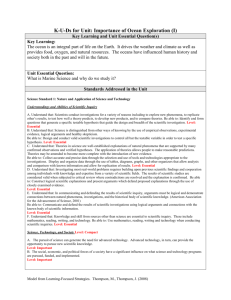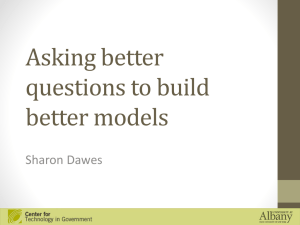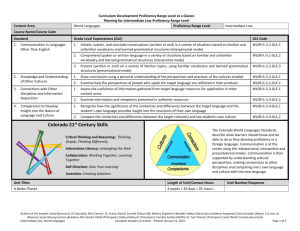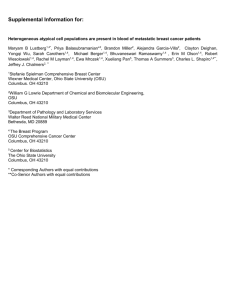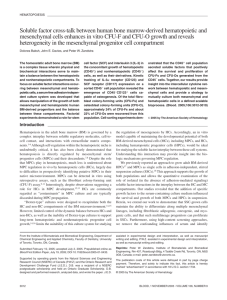Chptr 3 Heredity Notes
advertisement
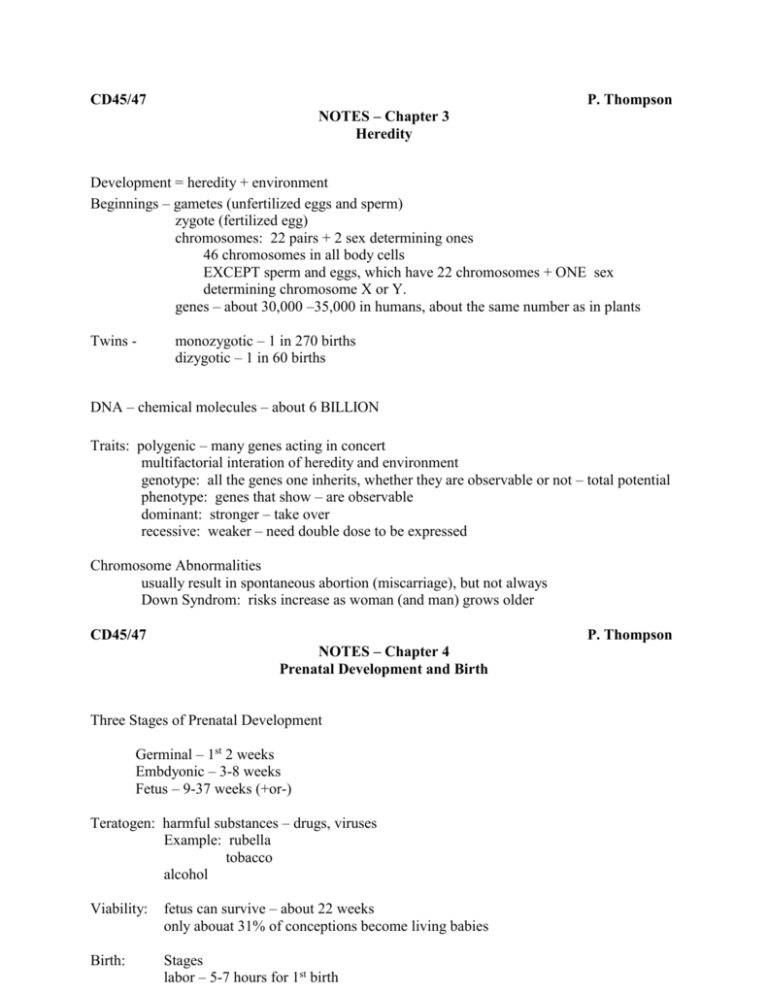
CD45/47 P. Thompson NOTES – Chapter 3 Heredity Development = heredity + environment Beginnings – gametes (unfertilized eggs and sperm) zygote (fertilized egg) chromosomes: 22 pairs + 2 sex determining ones 46 chromosomes in all body cells EXCEPT sperm and eggs, which have 22 chromosomes + ONE sex determining chromosome X or Y. genes – about 30,000 –35,000 in humans, about the same number as in plants Twins - monozygotic – 1 in 270 births dizygotic – 1 in 60 births DNA – chemical molecules – about 6 BILLION Traits: polygenic – many genes acting in concert multifactorial interation of heredity and environment genotype: all the genes one inherits, whether they are observable or not – total potential phenotype: genes that show – are observable dominant: stronger – take over recessive: weaker – need double dose to be expressed Chromosome Abnormalities usually result in spontaneous abortion (miscarriage), but not always Down Syndrom: risks increase as woman (and man) grows older CD45/47 P. Thompson NOTES – Chapter 4 Prenatal Development and Birth Three Stages of Prenatal Development Germinal – 1st 2 weeks Embdyonic – 3-8 weeks Fetus – 9-37 weeks (+or-) Teratogen: harmful substances – drugs, viruses Example: rubella tobacco alcohol Viability: fetus can survive – about 22 weeks only abouat 31% of conceptions become living babies Birth: Stages labor – 5-7 hours for 1st birth transition – head moes into vagina (birth canal) delivery – head crowns, followed by body APGAR – measures new born health Complications: anoxia low birth weight preterm small for age (SGA) post partum depression Bonding CD47 Pat Thompson Chapter 5 Bio Social Development Infancy/Toddlerhood Physical Growth Height Weight at birth 20 in. 6-9 lbs. 4th month double birth weight 12 months 30 in. 22 lbs. 24 months 32-36 in. 30 lbs. (Two year olds have attained 1/5 adult weight, ½ adult height.) SIDS – prevention Neurons Myelination: Speeds communication. Allows child to gain more control over functions. Reflexes – Types 1. maintain oxygen supply 2. maintain body temperature 3. manage feeding Gross motor skills Fine motor skills Sequence of motor skills Sensation: Sensory response, whether detected or not. Perception: Mental processing of sensory information. Vision: Newborns focus clearly at between 4-30 in. Hearing: Quite sensitive in newborns. Young babies able to distinguish different sounds easily. Adults cannot distinguish as well. Prevention of hearing loss: reduce ear infections – careful hand washing. Taste, Smell, touch: Less developed, but still sensitive. Ideal Diet: Breast milk. Malnutrition – in developing countries. CD47 Pat Thompson Chapter 6 Cognitive Development – Infancy/Toddlerhood Dynamic perception: Ability to connect the senses, i.e. – “See what I feel” “Hear what I see” Object permanence: “Things are there, even if I can no longer see them.” Starts at about 8 months of age. A-B error – continues until about 12 months of age. Baillargeon’s Tests of Object Permanence Possible event Impossible event Piaget Active intelligence – seek to understand in age related ways. Sensori – Motor Intelligence – 6 sub stages. Language Development Babbling First words – age 12 months Referential – names, labels, nouns more common. Ex.: Mom, dog. Expressive – interaction words more common. Ex.: Go, want. Underextension: Too limited – undergeneralization. Overextension: Too broad – overgeneralization. Holophrase: Single word sentences. Telegraphic speech: Only the important words. LAD – inborn. CD47 Pat Thompson Chapter 7 Psycho-Social Development – Infancy/Toddlerhood Emotional expressions seen in first month of life. First emotion: distress. Social smile – appears at 6 weeks. Social referencing – looking to parents for emotional cues. Dads encourage bold, playful behavior. Self awareness: Fosters growth of emotions – positive and negative. Ex.: guilt, shame, anxiety, pride. Personality Theories 1. Learning Skinner: Based on reinforcement. 2. Psychoanalytic: Freud, Oral Anal Fixations 3. Psychoanalytic - Erikson Trust vs. mistrust Autonomy vs. shame & doubt Temperament – 9 dimensions 3 types: easy – 40% slow-to-warm – 15% difficult – 10% Attachment Proximity – seeking Contact – maintaining Secure attachment Insecure attachment CD45/47 P. Thompson Chapter 8 Outline/Key Concepts Growth Slows down, child becomes slimmer; lower body lengthens; some baby fat melts. Eating Habits appetites decrease – normal iron deficiency anemia causes chronic fatigue lack of meat, grains, eggs, dark green veggies preschoolers compulsive about food, meals Factors Affecting Height Brain Growth myelination – on going reaction time quicker, control better Accidents/Injury better prevention through laws Physical Skills gross fine Child Maltreatment community/cultural context CD45/47 P. Thompson Chapter 9 Outline/Key Concepts Preoperational Thought – Piaget Guided Participation – Vygotsky children as apprentices scaffolding private speech Scripts Language fast mapping nouns, verbs easiest grammar how can parents help Head Start score higher – achievement tests better report cards fewer in remedial classes more likely to go to college less likely to go to jail! CD45/47 P. Thompson Chapter 10 Outline/Key Concepts Initiative vs. Guilt – Erikson Optimistic, competent, enthusiastic, bold Emotional Regulation how parents can help with fears Aggression Instrumental reactive relational bullying Play helps children learn social skills rough-&-tumble socio dramatic mastery imaginary playmates Effects of TV watch about 20-25 hours per week promotes aggressive behavior – takes time from play Parenting Patterns authoritarian authoritative permissive-democratic/indulgent permissive-neglecting traditional Gender Roles children prefer to play with same sex from age 2 onward Freud – Oedipus Complex – Electra Complex resolution – identification CD45/47 P. Thompson Chapter 11 Outline/Key Concepts Development between ages 7 and 11 is rather uneventful, relative slow. Children become slimmer. Variations in height and weight in this country is mainly due to heredity. In poorer nations – nutrition. Obesity: a growing problem Causes: heredity activity level TV cultural attitudes – love = food Solution: increase physical activity – no bribery, no crash diets Motor Skills: boys and girls about equal in abilities. Skill depends on: motivation guidance practice, practice, practice Sports programs should be fun! Problems: competitive comparing children to each other time spent on side lines, etc. BORING Developmental Problems – psychopathology 1) all of us have some problems – abnormality is normal 2) disabilities change over time – adulthood can be better or worse 3) label depends on social context Mental retardation vs. learning disabilities dyslexia dyscalcula ADHD – amphetamines help at home and school CD45/47 P. Thompson Chapter 12 Outline/Key Concepts Mental processing much more effective now. Kids know more, can use selective attention, metacognition, things become automatic. Concrete Operational Thought – Piaget 5 to 7 shift identity – an egg is still an egg when it’s scrambled. reversibility – even if we fight we can go back to being friends Kohlberg – Moral Reasoning: 6 stages morality of justice morality of caring Communication Skills jokes secret languages logic code switching: formal code informal code CD45/47 P. Thompson Chapter 13 Outline/Key Concepts Freud: latency – drives are quieter – time for mastering society’s developmental tasks. Erikson – industry vs. inferiority – competent/incompetent Children in most cultures are expected to show independence/responsibility, starting at age 6. Also expected to begin to understand motives, emotions, intentions of others – “walk a mile …… moccasins. Known as social cognition. Society of Children kids now demand more of friends, pickier. Tend to choose friends who are similar to themselves Two types of rejected children: aggressive-rejected withdrawn-ejected – most likely to be bullied Bullying – can be slowed/stopped by educating both bullies/victims – Norway has a national policy. Bullies usually have “groupies”/friends who admire/fear them. Family Styles: open: every family member contributes closed: strict guidelines, limits, rules Divorce: Is usually harmful to the children – at least in short term. – lower school achievement, poorer health, economic loss. same is true for homeless children. CD45/47 P. Thompson Chapter 14 Key Concepts Puberty: ends childhood - produces adult size, shape, sexual potential. Hormones: kick in from hypothalamus in brain. Growth hormone – both sexes Testosterone – more in males than females Estrogen – more in females than males Menarache/spermarche Earlier for Afro-Americans Later for Asian-Americans Growth Spurt: both boys and girls have similar increases in weight and height. 1. Proceeds from extremities 2. Rapid weight gain – girls gain more fat: ¼ body weight is fat – 1/8 boys girls gain more (proportionally) in hips and legs. 3. Growth spurt may occur at widely different ages. 4. Adolescents want to develop “on time” – a particular problem for early maturing girls. Organ Growth/Change 1. Lungs increase in size, capacity 2. Heart – doubles in size 3. Oil, sweat glands become much more active 4. Eyes elongate – may become nearsighted Primary Sex Characteristics Secondary Sex Characteristics Body Image – girls more dissatisfied with more body parts – almost all want to lose weight. Sexual Abuse: Can include teasing, invading privacy. Most abusers are male, BUT 20% are female. CD45/47 P. Thompson Chapter 15 Key Concepts Piaget: Formal Operations Can think in terms of possibilities, abstractions hypothetical – maybe/possibly still situation specific. Can reason against their own personal beliefs. Can use reasoning that is Inductive: from particulars to the general – BOTTOM UP Ex: If it walks and quacks like …. it must be …. . Deductive: from general to specific – TOP DOWN Ex: Ducks waddle and quack. This animal … & … . It must be a duck. Elkind: Adolescent Egocentrism: focus on selves, see selves as unique. Invincibility fable: won’t happen to me. Personal fable: see selves as heroic. Imaginary audience: “everyone is looking at me”. Schools: Best are supportive – teachers offer supportive interaction. Most are not supportive. Social promotion. Task involvement learning vs. group learning. Work and school – is the work meaningful – how many hours – no more than 15. Pregnancy: Causes multiple, long term problems. Understanding of basic facts doesn’t necessarily lead to responsible behavior. CD45/47 P. Thompson Chapter 16 Key Concepts Erikson: Identity vs. role confusion Identity achievement – ultimate status Foreclosure Negative identity Identity diffusion Identity moratorium Process can take 10 years or more – people going through several statuses before reaching ultimate status. Identity easy to achieve in societies where everyone has same values and change is slow. Conflict Probably inevitable; usually not serious. Adolescents don’t benefit from extreme laziness or abusive strictness. Other aspects: Communication Support Control – restricts autonomy – there is a fine line. Peers: Can sometimes act as buffers between dependence of childhood and independence of adult hood. Suicide: Suicid al idention – so common in adolescence that some experts consider it normal. Para suicide – self-destruction – may or may not be attempted suicide. Law Breaking: Statistics show males more likely to be arrested than females – blacks more likely than whites – whites more likely than Asians. But …. these are only arrest statistics – gender and ethnic differences may really be smaller – if non-arrested lawbreakers were included. CD47 NOTES - CHAPTER 17 Sex Among married couples frequency of sexual activity declines with age. Men: Require longer to attain an erection as they age; require more direct stimulation. Refractory period is longer (period following orgasm - when sexual arousal is not possible). Women: Become more easily aroused and experience more orgasms as they grow older experience and longer fore play. The capacity for sexual pleasure is unaffected by biological aging well into late adult hood. Infertility - inability to conceive after a year of trying. Male: Most common problem - low healthy sperm count. (motility) (swimming ability) (mobility) Normal sperm count per ejaculation: 80 million plus. Female: Most common reason - failure to ovulate - ovulation becomes more erratic as women age - sometimes release more than one egg per cycle. Older women more likely to have multiple births. Also due to fertility drug. Dieting/Disease Set points: A particular weight that an individual body strives to maintain. Affected by various factors: genetics, diet, age, etc., but body strives to maintain and metabolism changes. Cultural norms in western cultures can lead to unhealthy thinness, more common in women and less common in black women. Can never be too rich or too thin. Most likely to diet without needing to. Young, well educated women. Anorexia Insufficient fat halts hormone functioning - menstrual cycle anorexia - typically a young, high achieving white, female. Bulimia: Binge and purge - barf and scarf - most common among female college students and athletes Changes in sexual arousal vis-a-vis aging. men: longer time needed women: arousal/orgasm more likely Infertility: 12 months of trying with no luck. 1/3 of untreated couples eventually have a child. 1/2 of treated couples don't have child. men: too few active, live sperm women: Medical Advances solution: build up sperm count be waiting 3 days before ejaculation 1) ovulation becomes less regular - even if menstruating 2) blocked fallopian tubes - caused by PID, (pelvic inflammatory disease) 3) endometriosis: blocks reproductive tract 4) uterine problems, infections, fibrous tumors - prevent implantation 1) IVF - invitro fertilization: ova removed, fertilized in lab, inserted into uteras 2) GIFT - gamete intra Fallopian transfer: inserting sperm and ova (gametes) into Fallopian tube 3) AIFT - zygote intra Fallopian transfer: inserting fertilized ova (zygote) into Fallopian tube Dieting/Disease Set point: not rigidly fixed genetics and environment influence. Setting point - may be better term. Body mass Index (BMI) your natural (healthy) weight may vary 20 lbs. from other healthy people. Anorexia Bulimia The problem with women and diets: knowledgeable about nutrition, diets, but fail to remember they usually gained back more than they lost. KEY CONCEPTS/ Notes Chapter 18 Experience affects moral reasoning; examples: the college experience, sustained responsibility for welfare of others, making irreversible moral choices. Both males and females construct principles both relative and changeable: justice AND care. Adult Thinking: More pragmatic (practical) personal; fewer absolutes. Schaie: Stages of Adult Thought and Attitudes Child/Adol Early Adult Middle Adult 1) acquisition: like sponges - soak up everything - indiscriminate 2) achieving: goal directed 3) responsible: cares for well being of others - family, friends executive: cares for larger social systems 4) reintegrative: make sense of life as a whole Beyond Piaget - Postformal (?) - adaptive interaction between abstract, objective thinking and subjective feelings and experience. Notable life experiences can trigger a change in patterns of thinking/cognitive development. In general thinking in adult hood is toward a more responsible, committed view of the world. Chapter 19 Erikson - Intimacy vs. isolation - friendship and romantic partnering generativity vs. stagnation Social clock: "It's about time" Gender differences in friendship men don't tend to talk about personal matters - women do Divorce - rate has leveled off but at high rate 50% is usually worse than anticipated I) fail to realize what's positive in the relationship 2) people are still emotional about each other after the breakup - mixed feelings Spouse Abuse 1) common couple - usually verbal 2) patriarchial terrorism - usually physical, as well Chapter 20 Normal changes in Middle Adulthood Gray hair, wrinkles, middle age spread, muscles lose strength - causes vertebrae to compact somewhat, which causes height loss, hearing loss for door bells, telephones, loss of near vision - problem: glaucoma. Abnormal changes Mortality - death Morbidity - disease Disability - inability to perform activities most others of same general age group can Vitality - energy Ethnicity and Health Sex differences more marked than racial differences Women less likely to die However, women have more chronic, disabling conditions Most research done on men because it has focused on acute conditions rather than chronic ones Sex Changes Menopause (average age 5 1) / climacteric (6 years before actual menopause) Menopause symptoms: hot flashes, hot fluses, cold sweats usually caused by lower estrogen levels Hormone Replacement therapy (HRT) Benefits: reduces hip fractures - osteoporosis reduced risk of Alzheimer's Risks: slightly increased risk of breast cancer Most women have already decided to end child bearing before menopadse - have few regrets about children not born. There is no "male menopause" - although testosterone may dip due to sexual inactivity or anxiety, etc. Chapter 21 Fluid intelligence Crystalized intelligence Chapter 22 Big Five Personality Traits neuroticism extroversion openness agreeableness conscientiousness Quite stable by age 30. People have established an ecological niche. Traits are more valued in some cultures than certain others. U.S. openness. In middle age women become more assertive; men become more nurturing/emotional. CD47 P. Thompson NOTES – CHAPTER 23 Ageism: Prejudice against elderly. Demographic pyramid: Becoming square. Elderly, age 75+ fastest growing age group – worldwide. Subcategories of Aged Young-old – under 75 Old-old (middle old) – 75-85 Oldest-old – 85+ Types of Aging Primary: universal, irreversible changes Secondary: may be prevented, slowed down, reversed. Both are result of many factors: multiple pathways Vision Most older people (80%) see quite well with glasses Problems – Cataracts: thickening of lens Glaucoma: hardening of eyeball caused by fluid buildup Hearing Loss affects about 40% of people over age 65. Many refuse to wear aids – don’t want to appear old-ageism. Sleep Older people take longer, spend less time, wake up often, take more naps, etc. Some of this quite normal. Disease Both chronic and acute increase with age. Autopsies usually show cancer tumors, even if people died of something else. Ex: prostrate cancer. Theories: Causes of Aging 1. Wear-&-Tear: bodies wear out through use – not really so for humans. “Use it or lost it”. 2. Cellular accidents: body manufactures new cells, but new cells not as good – mutated. Oxygen free radicals: molecules separated from their atoms – can scramble DNA molecules – best defense: antioxidants. Vitamins C & A Foods rich in beta-carotene, the plant form of vitamin A acorn squash apricots beets broccoli carrots collards dates green peppers kale mangoes peaches prunes pumpkin red peppers spinach squash tomatoes Immune System Attack Cells B cells – made by bone marrow – destroy bacteria and viruses. T cells – made by thymus gland – attack any kind of infected cells. People with stronger immune systems live longer. Decline in immunity may be cause of aging. Immune-System Enhancers broccoli Brussels sprouts cantaloupe cauliflower lime peppers potatoes oranges grapefruit grapefruit juice lemon orange juice strawberries Maximum life span for humans: about 120 years. Average life expectancy has improved because babies/children are now surviving in greater numbers than in earlier times. Characteristics of Long Lived People/Regions 1. Moderate diet – mostly vegetables, little meat. 2. Work continues through life. 3. Family and community important, integrated. 4. Exercise, relaxation part of every day. CD47 P. Thompson Key Concepts Chapter 24 Cognitive Development – Late Adulthood Individual variation in cognitive functioning is greater in old age. Individuals show both greater deterioration and less. Explicit memory: consciously learned data, words, etc. More easily retrieved. Implicit memory: automatic memories – routines – it’s easy to ride a bicycle – difficult to describe how. Retrieval more difficult for recently learned information. Old knowledge shows little decline, even if it hasn’t been used. EXAMPLE: Spanish retention. Memory and Daily Life – few older adults think memory problems are a significant handicap. - Some slowing of thinking can be halted, even reversed – EXERCISE – sends blood to the brain. - Thinking/mental stimulation can cause dendrites to make new connections. - Hormone replacement therapy, antioxidants, even aspirin, ibuprofen can help. Nursing homes – reinforce passivity. Training in self-help is useful in preserving health. Dementia: irreversible loss – impaired judgment. I. Alzheimer’s = plaques and tangles in cerebral cortex – destroy normal functioning. Stages: 1. absent mindedness about recent events 2. confusion becomes more generalized 3. memory loss becomes dangerous – can’t manage daily affairs 4. 5. need full time care fail to respond – become mute II. Multi-Infarct Dementia: obstructions of blood vessels, prevents sufficient blood from reaching brain. Prevention: improve circulation, control blood pressure, diabetes. III. Reversible Dementia 1. drug interactions – may cause confusion, etc. 2. depression Life Review – person attempts to put life in perspective. CD47 P. Thompson Key Concepts Chapter 25 Erikson: integrity vs. despair Selective optimization – figure out how to achieve goals despite limitations. Theories of Social Development 1. disengagement theory: withdrawal, passivity. 2. continuity theory: social self is maintained throughout adulthood - going back to school - volunteering - politics Widowhood: men have more difficulty than women – difficulty in revealing feelings, asking for help. Divorce: men have more difficulty handling it than women. Elder Abuse: mainly family members. Epilogue Stages of dying – Kubler-Ross 1. denial 2. anger 3. bargaining 4. depression 5. acceptance – devoid of feelings Other researchers have found that people go back and forth among stages. Family, as well. Conspiracy of silence – no one willing to talk about dying – doctors now usually willing to be frank – but only if patient asks. Pain medication still under-prescribed. Living Will: indicates what treatment patient wants/or doesn’t want if patient can’t express desires. D.N.R. Double effect of pain medication: 1. pain reduction palliative care 2. may hasten death Death Rituals Culture often has more influence than religion. Mourning has become more private, less emotional, less religious. Survivors may experience manifestations of sorrow over long periods of time – quite normal.



